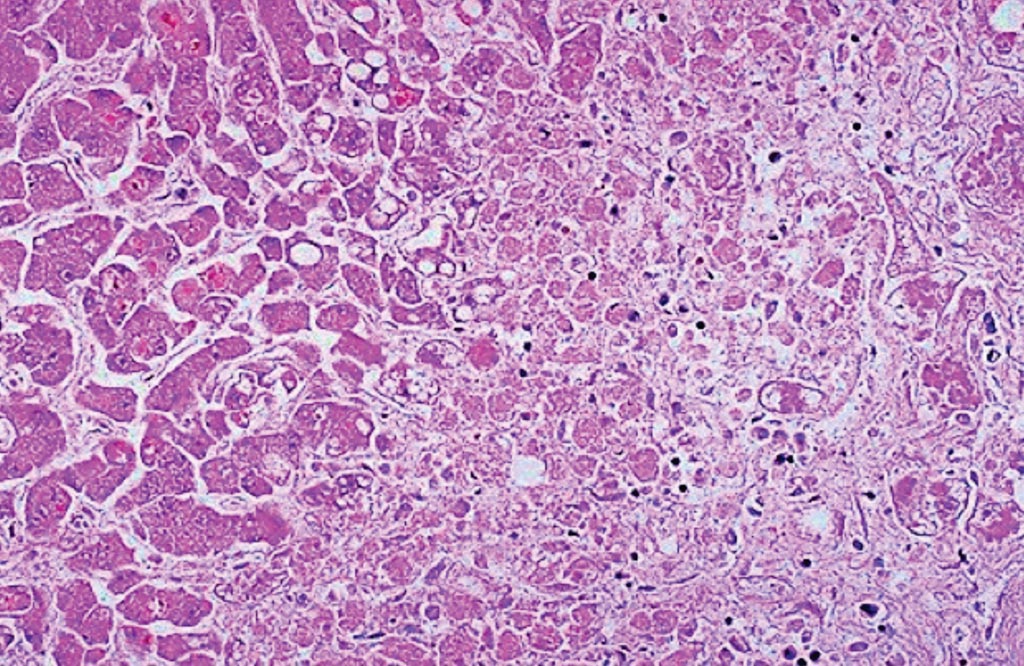Test Detects Overdose Patients at Risk of Liver Damage
By LabMedica International staff writers
Posted on 28 Nov 2017
Paracetamol is a safe analgesic drug when taken at therapeutic doses; however, in overdose, paracetamol is hepatotoxic and is the most common cause of acute liver failure in the USA and Europe.Posted on 28 Nov 2017
Current markers, serum alanine aminotransferase (ALT) activity and paracetamol concentration, lack sensitivity and specificity when measured soon after overdose such as at initial presentation to hospital. These limitations are further compounded in staggered overdose, for which there is an increased acute liver injury risk, but for which treatment nomograms are not recommended.

Image: A histopathology of extensive hepatocyte necrosis seen here in a case of paracetamol overdose. The hepatocytes at the right are dead, and those at the left are dying. This pattern can be seen with a variety of hepatotoxins (Photo courtesy of the University of Utah Medical School).
A team of medical scientists by the University of Liverpool (Liverpool, UK) and the University of Edinburgh (Edinburgh, UK) recruited two cohorts to assess the potential for biomarkers to stratify patients who overdose with paracetamol. The team completed two independent prospective studies: a derivation study (MAPP) in eight UK hospitals and a validation study (BIOPAR) in ten UK hospitals. Patients in both cohorts were adults (≥18 years in England, ≥16 years in Scotland), were diagnosed with paracetamol overdose.
Blood sample taken at first presentation to hospital was stored at −80 °C as plasma or serum. All blood results from the first hospital admission were recorded (paracetamol, alkaline phosphatase, γ-glutamyl transferase, bilirubin, creatinine, and alanine aminotransferase (ALT) concentration, prothrombin time, and international normalized ratio [INR]). The primary endpoint was acute liver injury indicating need for continued acetylcysteine treatment beyond the standard course (ALT activity >100 U/L.
The reference standard of injury was ALT concentration. MicroRNA-122 (miR-122), high mobility group box-1 (HMGB1), caspase-cleaved keratin-18 (K18), full-length K18, and glutamate dehydrogenase (GLDH) were measured in the admission blood sample, with miR-122 measured by polymerase chain reaction (PCR) and other markers measured by enzyme-linked immunosorbent assay (ELISA). Each biomarker was measured in each sample in duplicate. miR-122 concentration was expressed with reference to the circulating microRNA let-7d as the internal microRNA normalizer.
The team reported that between June 2, 2010, and May 29, 2014, 1,187 patients who required acetylcysteine treatment for paracetamol overdose were recruited (985 in the MAPP cohort; 202 in the BIOPAR cohort). In the derivation and validation cohorts, acute liver injury was predicted at hospital presentation by miR-122, HMGB1, and full-length K18, and results were similar in the validation cohort. A combined model of miR-122, HMGB1, and K18 predicted acute liver injury better than ALT alone.
James W Dear, FRCP, the lead author of the study, said, “Paracetamol overdose is very common and presents a large workload for already over-stretched Emergency Departments. These new blood tests can identify who will develop liver injury as soon as they first arrive at hospital. This could transform the care of this large, neglected, patient group.” The study was published on November 13, 2017, in the journal Lancet Gastroenterology & Hepatology.
Related Links:
University of Liverpool
University of Edinburgh













